You misread my assumptions. The only thing assumed is current production and yield relating to current 4680. We know they have 2-4 4680 linea at Austin. 200,000 cars per year is 200,000,000 cells per year. That is 550,000 cells per day. 380 cells per minute. With 4 lines at Austin, that’s 95 cells per minute per line. More than 1.5 per second. And the reported 1 million sitting at Kato would be 2 days worth of production if they are at production speed that matches full ramp at Austin.
This would be very easy to verify with the drone footage we have seen of the battery lines. You’d at least see people at the end of the lines stacking finished cells for transport to the battery pack production area.
As I type this I look to verify my number and I find this (also the source of the 1 millions cells number):
Until the point they need to lower the price for competitive reasons. But if they can’t lower the price across the fleet (produced in Texas vs ca) then they will be their own competition. Yes, eventually once both assembly lines are converted they would have more price flexibility. But those...

teslamotorsclub.com
13 machines produce 6300 cells per day (one training Texas employees had 82% reject rate). Roughly 500 cells per machine per day. Even if they are only running 8 hours per day and they shift to 24 hours a day that’s 1500 cells per machine per day. That changes the above math to needing 350+ machines running 24 hours a day to produce. Looking closer at the numbers, machines 109, 206 and 208 produced close to 900 good cells per day. Using those numbers reduces the number of machines needed by roughly half. Close to 200 machines. The range of that day for all the machines is 103 to 965 cells produced. That is a large range and shows you how far Tesla is from getting 4680 production remotely close to what they need for full production. Also, if 14 machines is enough to be the 10th largest facility in the world, they need much more production to reach that slot (currently around 25 GWh per year).
If current 2170 are 5000mah, same energy density would be 27,000mah for 4680. 4416 2170 at 3.6v is 79.8kWh. This means about 820 4680 needed for same capacity. That’s basically one machine per car per day at current best case scenario yields. The 1 million 4680 cells at 27ah each is equivalent of 97MWh. To get to #10 biggest factory they need to produce 250 times this in a year. 250 million cells across 14 machines is almost 18 million cells per machine. Almost 50,000 cells per machine per day. They are currently producing 900 under best case scenario. 2700 if running continuously assuming they are at 8 hours per day now. That’s 1.3GWh. Best case. Accounting for averages, about half of that. Long way to go to get to the 10th largest battery factory in the world as currently configured.
All this hype is just that, hype. Do the math. Elon always speaks of the future. Every statement he makes has a whole lot of unsaid IFs behind it. iF we get the yields and production rates we think we can get, IF we have enough lines, IF we have enough raw material, THEN it will be the 10th largest battery factory in the world.

teslamotorsclub.com




